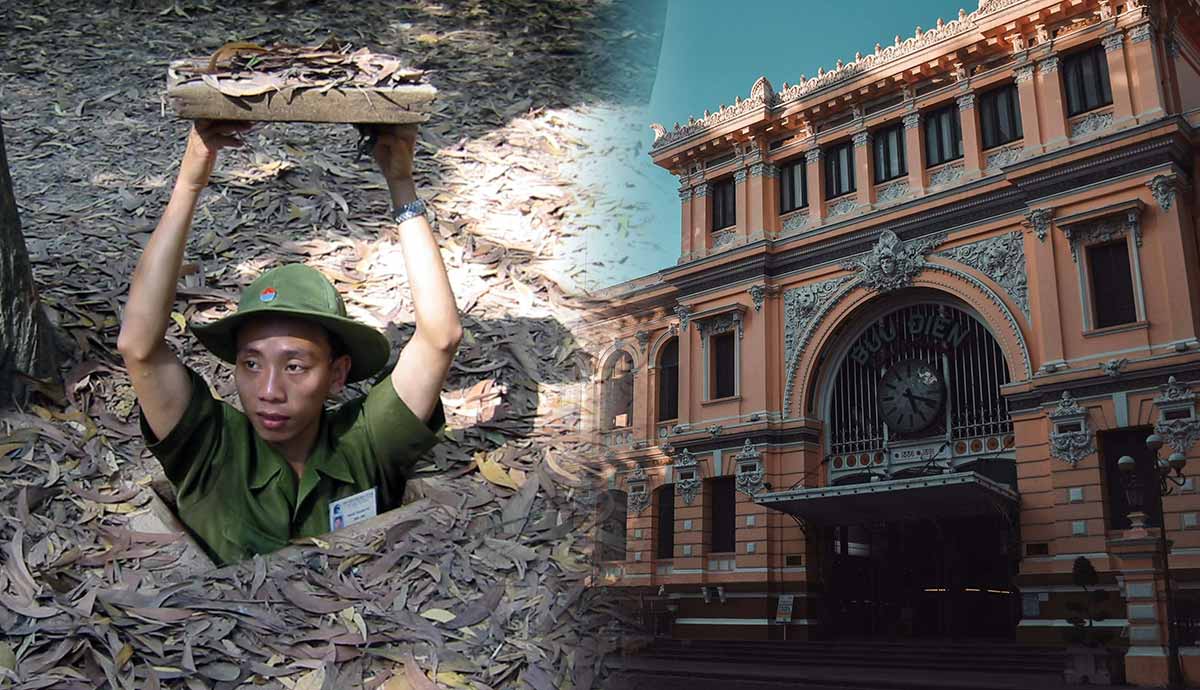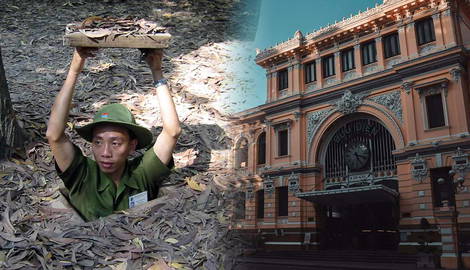
Beneath the hustle and bustle of Ho Chi Minh City, formerly known as Saigon, lies countless fascinating sites. Visitors usually overlook Vietnam’s most populated city and financial center in favor of Hanoi or the country’s countless beach destinations. However, Ho Chi Minh City is more than simply a stopover. This city of two names is a fantastic intersection of old and new, and East meets West. From colonial architecture to traditional Vietnamese food offerings to the city’s many rivers and canals, this sweltering Southeast Asian metropolis begs to be explored.
1. Notre Dame Cathedral Basilica of Saigon

Standing tall amid Ho Chi Minh City’s financial hub and skyline sits something slightly out of place. Visitors exploring the city’s main tourist area, District One, will be surprised to find a majestic cathedral. They may question where they are: could this piece of architecture really be tucked into a roundabout in Vietnam? Why yes, of course. Initially built in the 1880s by French colonists, the Notre Dame Cathedral Basilica of Saigon is a must-see historic spot for those visiting the city.
After France’s Admiral Charles Rigault de Genouilly conquered Saigon in 1859, the Roman Catholic Church created a community, and of course, French colonists needed a place to worship. The construction of the cathedral began in 1863 after the first wooden structure was deemed too small for the area and was unfortunately eaten away by termites.
The French wanted the cathedral to be as authentically theirs as possible and spared no expense. All of the cathedral’s construction materials were imported to Vietnam from France. Due to the import, the cathedral’s original name was State Cathedral.
The two bell towers reached 58 meters and were constructed in 1895. The cathedral has had several name changes throughout its history. It earned its current moniker in 1962.
In October 2005, the cathedral came to the forefront after claims that one of its Virgin Mary statues shed tears. While never confirmed, this caused quite the uproar, with thousands trying to get a peek of the “Weeping Virgin Mary.”
The cathedral is currently undergoing renovations set to be completed in 2027.
2. War Remnants Museum

A trip to Ho Chi Minh City is incomplete without visiting the equally somber and sobering War Remnants Museum. According to the museum’s website, its goal is to “…study, collect, conserve and display exhibits on war crimes and consequences inflicted on the Vietnamese people by foreign aggressive forces.” The museum aims to use history to promote its message of peace and boasts over a million visitors each year.
The museum punches each visitor or passersby in the face right away. United States military vehicles, artillery, and other weaponry are outside the facade. It is almost impossible not to go inside and see more. History is on full display right out front. The museum has nine permanent exhibits, special exhibits, and host speakers, and it often has traveling exhibits as well.
While the museum primarily focuses on Vietnam’s war with the United States (known as the American War in Vietnam or, by some, the Second IndoChina War), there are also exhibits surrounding the first IndoChina war with the French.
What makes the museum a necessary historical stop, especially for Westerners, is to see the Vietnam War through the lens of the Vietnamese. While at times this can be graphic, it is also important. Visitors learn about the harsh conditions for prisoners, the effects of the horrendous Agent Orange, as well as the aftermath of the war for the Vietnamese.
3. Hotel Continental Saigon

Located on the bustling main drag of Dong Khoi Street in District One, right in the center of the city, is the Hotel Continental Saigon. The building’s white facade beckons visitors to walk into the past for a snack, a full meal, or even a stay in this historic hotel.
The Hotel Continental Saigon opened in 1880 as a respite for the French to have French-style luxury accommodation, and it has remained largely untouched for over 140 years. Stepping through the hotel doors truly feels like stepping back in time. While the hotel has been renovated many times, the renovations have always been to preserve the original feel and design of the hotel.
The hotel became a key meeting place for journalists and politicians during the first Indochina War. Notably, long-time hotel guest and British novelist Graham Greene wrote his novel The Quiet American while staying at the hotel. The novel tells the story of the breakdown of French Colonialism in Vietnam. The hotel was featured in both film versions of the novel.
During the Vietnam War, the hotel’s second floor became the bureau of Newsweek and Time Magazine.
4. Ho Chi Minh City Book Street

Tucked in a tiny street right smack dab in the heart of booming Ho Chi Minh City is the most adorable little book street, one of Ho Chi Minh City’s oldest.
The street, originally constructed during the French Colonial Period and known first as Hong Kong Street, is now a 100-meter (328 ft) car-free, pedestrian-friendly alleyway dedicated not only to books but also to cultural events.
It is a must-stop historic site because the street has been part of the city’s fabric for hundreds of years and showcases the city’s architecture.
The small street is situated near the Notre Dame Cathedral and the Ho Chi Minh City Post Office. Walking down the street gives visitors a modern, tree-lined refuge juxtaposed against the city’s chaotic backdrop.
Since 2000, the space has been known as Nguyen Van Binh Book Street, named for a famous Vietnamese scholar, to help promote literacy. However, the street was not reconstructed into its current iteration until 2016. Strolling down the city’s oldest street with Vietnamese coffee and the latest best-seller is a must-do attraction. It is a truly unique historic travel experience.
5. Saigon Central Post Office

Another architectural gem in Ho Chi Minh City is the Saigon Central Post Office, one of the most recognizable and iconic in the city. The French built it between 1886 and 1891 to help create a communication system.
Famed French architect Gustave Eiffel, the same architect who designed the iconic Eiffel Tower, often gets credit for its design. However, it was actually French architect Alfred Folhoux.
The unique blend of Renaissance, Gothic, French, and Asian elements makes this an exceptional addition to any Ho Chi Minh City itinerary. Stepping inside the building, with its expansive hall and large windows, helps to highlight the green and yellow color scheme, beautiful tiled floors, and immaculate arches. It feels more like a European train station and can momentarily have people second-guessing if they’re still in Asia.
Inside, visitors can also find maps showing the original postal routes between Vietnam and Cambodia and other local maps.
6. Independence Palace

This sprawling white palace in District One of the city has experienced many changes throughout its history, just like Vietnam. The palace’s history is a dizzying back and forth, showcasing Vietnam’s long road to its current government.
Independence Palace, initially named Nordom Palace, was completed in 1871 and constructed as a palace for the Governor General of Indochina. Until 1945, It became the site of work and life for French General Governors. In March 1945, the Japanese overthrew the French and took control of the area and, therefore, the Palace.
However, the Japanese occupation of the Palace was short-lived, as the French reclaimed it after Japan’s defeat in World War II.
In the 1950s, the French handed the palace back to the Vietnamese. Throughout the rest of the 1950s and ‘60s, it was the site of both the Republic of Vietnam’s first presidential residence and an unsuccessful coup attempt.
In 1975, the palace became the site of Vietnam’s reunification after a tank smashed through the Palace’s gate. The national conference for the reunification of Vietnam was held at Independence Palace shortly after the Provisional Revolutionary Government’s control.
Today, the site is used as a tourist stop but still holds government proceedings.
7. Cu Chi Tunnels

One of the most popular tourist attractions in Ho Chi Minh City, and Vietnam in general, are the Cu Chi Tunnels.
The tunnel is a 250-kilometer-long (155-mile) system used by the Vietcong during the Vietnam War. The Vietcong dug this network of tunnels for use to hide troops, as soldier’s lodging, and also hospitals.
The Cu Chi Tunnels are part of a more extensive network of tunnels in Vietnam, but the tunnels in Ho Chi Minh are most famous for being the hiding spot of the Vietcong during 1968’s Tet Offensive and for its underground conference rooms.
The Cu Chi Tunnels were also known during the Vietnam War as a site for booby traps. Most notably, the Vietcong would deter intruders with sharpened bamboo and even, at times, scorpions. Many believe these tunnels were a cause of the United States’ withdrawal from the region, as they helped the Northern Vietnamese to survive.
The Vietnamese government preserved 120 kilometers (75 miles) of the tunnels after the country’s unification as a memorial and reminder. Today, many of the tunnels’ sites have been made larger to accommodate tourists.










